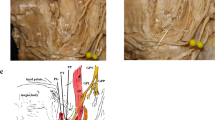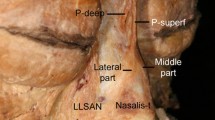Summary
Background: Reports concerning the innervation of the depressor anguli oris muscle by the marginal mandibular nerve are conflicting. The aim of the present study was to examine, by electrophysiology, whether the depressor anguli oris muscle is completely denervated after transsection of the marginal mandibular nerve and, if not, to determine the quantitative degree of volitional activity present in the muscle.
Methods: Five patients (4 men, 1 woman; mean age: 56 years; range: 44–63) with unilateral paralysis of the marginal mandibular branch of the facial nerve were examined by electrophysiology and clinically, 8 to 12 weeks after nerve resection. Electrically evoked potentials, pathological spontaneous activity and volitional activity in the depressor anguli oris muscles were assessed by needle electromyography and nerve stimulation.
Results: The electrophysiological examination showed a high-grade but incomplete lesion of the depressor anguli oris muscle and clinical examination revealed high-grade paresis of the lip depressors.
Conclusions: Co-innervation of the depressor anguli oris muscle by a nerve branch other than the marginal mandibular nerve was seen in the present study. Residual volitional activity due to this co-innervation was minor and clinically not relevant.
Zusammenfassung
Grundlagen: Die Innervation des M. depressor anguli oris durch den R. marginalis mandibulae wird in der Literatur nicht einheitlich angegeben. Ziel dieser Studie war es, zu untersuchen, ob eine Durchtrennung des R. marginalis mandibulae zu einer kompletten Denervation des M. depressor anguli oris führt und falls nicht, in welchem Ausmaß Willküraktivität vorhanden ist.
Methodik: 5 Patienten (4 Männer, 1 Frau, mittleres Alter: 56 Jahre) mit einseitiger Parese des R. marginalis mandibulae wurden elektrophysiologisch und klinisch 8 bis 12 Wochen nach der Nervendurchtrennung untersucht. Elektrisch evozierbare Potentiale, pathologische Spontanaktivität und Willküraktivität wurden für den M. depressor anguli oris untersucht.
Ergebnisse: Die elektrophysiologischen Untersuchungen zeigten eine hochgradige, aber inkomplette Läsion des M. depressor anguli oris, die klinischen Untersuchungen zeigten eine hochgradig Parese für die Funktion der Lippen- und Mundwinkeldepression.
Schlußfolgerungen: Der M. depressor anguli oris wurde überwiegend, aber nicht ausschließlich vom R. marginalis mandibulae versorgt. Die nicht vom R. marginalis mandibulae stammende Willküraktivität war gering und klinisch nicht relevant.
Similar content being viewed by others
References
Bernstein L, Nelson RH: Surgical anatomy of the extraparotid distribution of the facial nerve. Arch Otolaryngol 1984;110:117–183.
Conley J, Baker DC, Selfe RW: Paralysis of the mandibular branch of the facial nerve. Plast Reconstr Surg 1982;70:569–576.
Davis RA, Anson BJ, Budinger JM, Kurth LE: Surgical anatomy of the facial nerve and parotid gland based upon a study of 350 cervicofacial halves. Surg Gyn Obstet 1956;102:385–412.
Dingman RO, Grabb WC: Surgical anatorny of the mandibular ramus of the facial nerve based on the dissection of 100 facial halves. Plast Reconstr Surg 1962;29:266–272.
Dumitru D: Electrodiagnostic Medicine. St. Louis, Mosby, 1995.
Katz AD, Catalano P: The Clinical Significance of the Various Anastomotic Branches of the Facial Nerve. Arch Otolaryngol 1987;113:959–962.
Mark M: Anatomy of the Facial Nerve for the Clinician. In May M (ed): The Facial Nerve. Stuttgart-New York, Georg Thierne, 1986.
Martin H: The operative removal of tumors of the parotid salivary gland. Surgery 1952;31:670–682.
Kartush JM, Lilly DJ, Kemink JL: Facial Electroneurography: Clinical and Experimental Investigations. Otolaryngol-Head and Neck Surgery 1985;93:516–523.
Rödel R, Lang J: Die peripheren Äste des N. facialis im Wangen-und Kinnbereich. HNO 1996;44:572–576.
Rodgers JA, Rodgers WB: Marginal Mandibular Nerve Palsy Due to Compression by a Cervical Hard Collar. J Orthop Trauma 1995;9:177–179.
Rubin L: The Paralyzed Face. St. Louis, Mosby, 1991.
Sunderland S: Nerves and Nerve Injuries. London, Livingstone, 1968.
Waldeyer A, Mayet A. Anatomie des Menschen, Zweiter Teil. Berlin-New York, De Gruyter, 1979.
Author information
Authors and Affiliations
Corresponding author
Rights and permissions
About this article
Cite this article
Paternostro-Sluga, T., Kermer, C., Nuhr, M.J. et al. Needle electromyography of the depressor anguli oris muscle after transsection of the marginal mandibular nerve. Eur. Surg. 34, 234–236 (2002). https://doi.org/10.1046/j.1563-2563.2002.02037.x
Issue Date:
DOI: https://doi.org/10.1046/j.1563-2563.2002.02037.x




